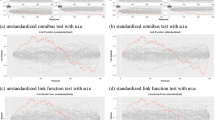Abstract
In this paper, we first propose a dependent Dirichlet process (DDP) model using a mixture of Weibull models with each mixture component resembling a Cox model for survival data. We then build a Dirichlet process mixture model for competing risks data without regression covariates. Next we extend this model to a DDP model for competing risks regression data by using a multiplicative covariate effect on subdistribution hazards in the mixture components. Though built on proportional hazards (or subdistribution hazards) models, the proposed nonparametric Bayesian regression models do not require the assumption of constant hazard (or subdistribution hazard) ratio. An external time-dependent covariate is also considered in the survival model. After describing the model, we discuss how both cause-specific and subdistribution hazard ratios can be estimated from the same nonparametric Bayesian model for competing risks regression. For use with the regression models proposed, we introduce an omnibus prior that is suitable when little external information is available about covariate effects. Finally we compare the models’ performance with existing methods through simulations. We also illustrate the proposed competing risks regression model with data from a breast cancer study. An R package “DPWeibull” implementing all of the proposed methods is available at CRAN.










Similar content being viewed by others
References
Allison P (2018) For causal analysis of competing risks, don’t use fine and Gray’s subdistribution method. https://statisticalhorizons.com/for-causal-analysis-of-competing-risks, statistical Horizons
Chen DGD, Sun J, Peace KE (2012) Interval-censored time-to-event data: methods and applications. CRC Press, Boca Raton
Cox DR (1972) Regression models and life-tables. J R Stat Soc Ser B 34(2):187–220
de Castro M, Chen M, Zhang Y (2015) Bayesian path specific frailty models for multi-state survival data with applications. Biometrics 71(3):760–771
De Iorio M, Müller P, Rosner GL, MacEachern SN (2004) An ANOVA model for dependent random measures. J Am Stat Assoc 99(465):205–215
De Iorio M, Johnson WO, Müller P, Rosner GL (2009) Bayesian nonparametric nonproportional hazards survival modeling. Biometrics 65(3):762–771
Dignam JJ, Zhang Q, Kocherginsky M (2012) The use and interpretation of competing risks regression models. Clin Cancer Res Off J Am Assoc Cancer Res 18(8):2301–2308. https://doi.org/10.1158/1078-0432.CCR-11-2097
Escobar MD, West M (1995) Bayesian density estimation and inference using mixtures. J Am Stat Assoc 90(430):577–588
Fan X (2008) Bayesian nonparametric inference for competing risks data. The Medical College of Wisconsin, Ph.D. dissertation
Fine JP, Gray RJ (1999) A proportional hazards model for the subdistribution of a competing risk. J Am Stat Assoc 94(446):496–509
Ge M, Chen MH (2012) Bayesian inference of the fully specified subdistribution model for survival data with competing risks. Lifetime Data Anal 18(3):339–363
Gelman A, Jakulin A, Pittau MG, Su YS (2008) A weakly informative default prior distribution for logistic and other regression models. Ann Appl Stat 2(4):1360–1383
Greep NC, Giuliano AE, Hansen NM, Taketani T, Wang HJ, Singer FR (2003) The effects of adjuvant chemotherapy on bone density in postmenopausal women with early breast cancer. Am J Med 114(8):653–659
Ishwaran H, Kogalur U (2018) Random forests for survival, regression, and classification (RF-SRC)
Klabunde CN, Legler JM, Warren JL, Baldwin LM, Schrag D (2007) A refined comorbidity measurement algorithm for claims-based studies of breast, prostate, colorectal, and lung cancer patients. Ann Epidemiol 17(8):584–590
Kottas A (2006) Nonparametric Bayesian survival analysis using mixtures of Weibull distributions. J Stat Plan Inference 136(3):578–596
Lee KH, Dominici F, Schrag D, Haneuse S (2016) Hierarchical models for semicompeting risks data with application to quality of end-of-life care for pancreatic cancer. J Am Stat Assoc 111(515):1075–1095
MacEachern SN (1999) Dependent nonparametric processes. In: ASA proceedings of the section on Bayesian statistical science, pp 50–55
Murthy VH, Krumholz HM, Gross CP (2004) Participation in cancer clinical trials: race-, sex-, and age-based disparities. J Am Med Assoc 291(22):2720–2726
Naskar M, Das K, Ibrahim JG (2005) A semiparametric mixture model for analyzing clustered competing risks data. Biometrics 61(3):729–737
Neal RM (2000) Markov chain sampling methods for Dirichlet process mixture models. J Comput Graph Stat 9(2):249–265
Neuner JM, Shi Y, Kong AL, Kamaraju S, Smith EC, Smallwood AJ, Laud PW, Charlson JA (2018) Fractures in a nationwide population-based cohort of users of breast cancer hormonal therapy. J Cancer Surviv 12(2):268–275. https://doi.org/10.1007/s11764-017-0666-4
Scrucca L, Santucci A, Aversa F (2007) Competing risk analysis using R: an easy guide for clinicians. Bone Marrow Transpl 40(4):381–387
Sethuraman J (1994) A constructive definition of Dirichlet priors. Stat Sin 4:639–650
Shi Y (2019) DPWeibull: Dirichlet process Weibull mixture model for survival data. https://CRAN.R-project.org/package=DPWeibull, r package version 1.4
Shi Y, Martens M, Banerjee A, Laud P (2019) Low information omnibus (lio) priors for dirichlet process mixture models. Bayesian Anal 14(3):677–702. https://doi.org/10.1214/18-BA1119
Snapinn SM, Jiang Q, Iglewicz B (2012) Illustrating the impact of a time-varying covariate with an extended Kaplan–Meier estimator. Am Stat 59(4):301–307
Sparapani RA, Logan BR, McCulloch RE, Laud PW (2016) Nonparametric survival analysis using Bayesian additive regression trees (BART). Stat Med 35(16):2741–2753
Therneau TM (2015) A package for survival analysis in S. https://CRAN.R-project.org/package=survival, version 2.38
Zhang Y, Chen MH, Ibrahim JG, Zeng D, Chen Q, Pan Z, Xue X (2014) Bayesian gamma frailty models for survival data with semi-competing risks and treatment switching. Lifetime Data Anal 20(1):76–105
Acknowledgements
The study was funded by the American Cancer Society (RSG-11-098-01-CPHPS to JMN).
Author information
Authors and Affiliations
Corresponding author
Additional information
Publisher's Note
Springer Nature remains neutral with regard to jurisdictional claims in published maps and institutional affiliations.
Electronic supplementary material
Below is the link to the electronic supplementary material.
Rights and permissions
About this article
Cite this article
Shi, Y., Laud, P. & Neuner, J. A dependent Dirichlet process model for survival data with competing risks. Lifetime Data Anal 27, 156–176 (2021). https://doi.org/10.1007/s10985-020-09506-0
Received:
Accepted:
Published:
Issue Date:
DOI: https://doi.org/10.1007/s10985-020-09506-0




